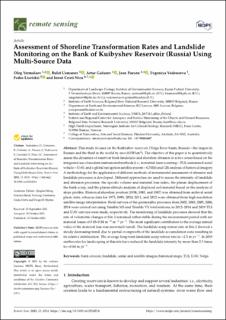| dc.description.abstract | This study focuses on the Kuibyshev reservoir (Volga River basin, Russia)—the largest in Eurasia and the third in the world by area (6150 km2). The objective of this paper is to quantitatively assess the dynamics of reservoir bank landslides and shoreline abrasion at active zones based on the integrated use of modern instrumental methods (i.e., terrestrial laser scanning—TLS, unmanned aerial vehicle—UAV, and a global navigation satellite system—GNSS) and GIS analysis of historical imagery. A methodology for the application of different methods of instrumental assessment of abrasion and landslide processes is developed. Different approaches are used to assess the intensity of landslide and abrasion processes: the specific volume and material loss index, the planar displacement of the bank scarp, and the planar-altitude analysis of displaced soil material based on the analysis of slope profiles. Historical shoreline position (1958, 1985, and 1987) was obtained from archival aerial photo data, whereas data for 1975, 1993, 2010, 2011, and 2012 were obtained from high-resolution satellite image interpretation. Field surveys of the geomorphic processes from 2002, 2003, 2005, 2006, 2014 were carried out using Trimble M3 and Trimble VX total stations; in 2012–2014 and 2019 TLS and UAV surveys were made, respectively. The monitoring of landslide processes showed that the rate of volumetric changes at Site 1 remained rather stable during the measurement period with net material losses of 0.03–0.04 m−3 m−2 yr−1. The most significant contribution to the average annual value of the material loss was snowmelt runoff. The landslide scarp retreat rate at Site 2 showed a steady decreasing trend, due to partial overgrowth of the landslide accumulation zone resulting in its relative stabilization. The average long-term landslide scarp retreat rate is—2.3 m yr−1. In 2019 earthworks for landscaping at this site have reduced the landslide intensity by more than 2.5 times to—0.84 m yr.
. | en_US |
